What to do if condensate in a gas boiler: methods for preventing the formation of “dew” in a chimney
Along with increasing the efficiency of modern heating equipment, the complexity of the units increases and the requirements for its maintenance increase. Agree, it is extremely unpleasant if, after a year or two after installing the device, you find condensate in a gas boiler: what to do in this case, we will tell you below.
If urgent measures are not taken, then the equipment itself and the chimney will begin to collapse. At the same time, inside the house equipped with the heating system, the walls will damp, red smudges will form, black mold will appear, the finish will become unusable.
Properly selected and correctly installed chimney will solve all the problems. Also, a steam trap will help to cope with the situation, which will significantly extend the life of the chimney system. From our article you will find out what condensate is, how to get rid of it and what a chimney should be like.
The content of the article:
What is condensate?
Condensate is a liquid that settles on the walls of the chimney as a result of temperature changes. In modern gas equipment, the exhaust gases have a low temperature.
Causes of condensation:
- improperly insulated chimney;
- sharp temperature difference;
- unheated pipes;
- clogged smoke channel;
- low temperature of the exhaust gases (ideally, the temperature should not be lower than 100 ° C);
- a very long chimney pipe, resulting in excessive cooling of the smoke;
- rough chimney walls (collect more water than smooth ones);
- structural defects;
- traction problems.
During the operation of the gas boiler, in addition to water, carbon dioxide and other chemical compounds (oxides) are also released.
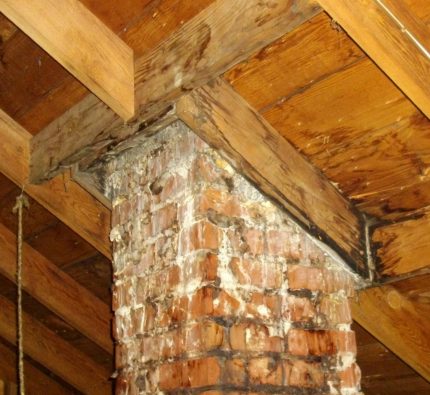
Under the influence of high temperature, the oxides react with water and aggressive acids are formed (nitric, hydrochloric, sulfuric, etc.). They settle on the surface of the equipment along with condensing vapors. Aggressive acidic environment leads to the rapid destruction of the chimney.
What is the danger of moisture formation:
- if the condensate freezes in the deflector or at the mouth of the pipe, the cross section of the chimney is blocked, as a result of the draft decreases, which can lead to the formation of reverse draft and combustion products will enter the house, causing poisoning of its residents;
- a large amount of water can extinguish the flame, which will cause carbon monoxide to enter the room.
In addition, if moisture gets into the furnace of the boiler, its walls will collapse. As a result of the destruction, toxic combustion products will partially enter the house.
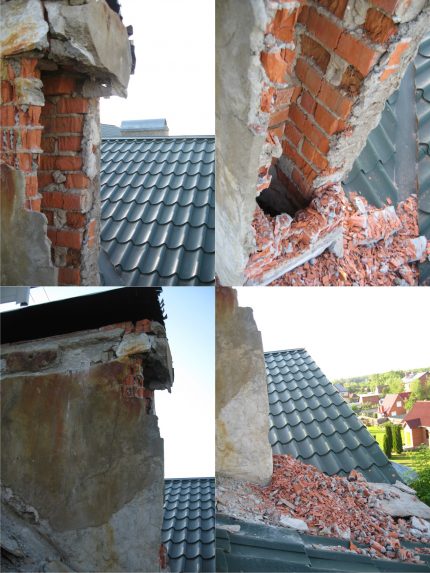
Exhaust gas contains water in the form of steam. When the temperature of the gases drops, the steam becomes oversaturated and droplets form. In the case when the gases are hot, the formation of condensate occurs at the colder walls of the chimney, where drops of liquid settle.
Why does moisture appear in gas boilers?
In addition to condensate in gas boiler chimney moisture can also form in water pipes. The main reason lies in the temperature difference.
Also, the appearance of “dew” on pipelines is affected by:
- improper ventilation (insufficient exhaust hood);
- high level of humidity in the room;
- incorrect operation of heating equipment.
The device of the gas boiler does not completely get rid of the condensate. However, it is in your power to reduce the rate of moisture formation and its amount.
Condensate control in atmospheric boiler
If the house has an atmospheric wall or floor gas boiler, then the combustion products are heated to 170-200 ° C. Water is also present in the gases formed during combustion. However, it does not condense, but turns into steam and is discharged through the smoke channel along with other smoke and volatile particles of soot.
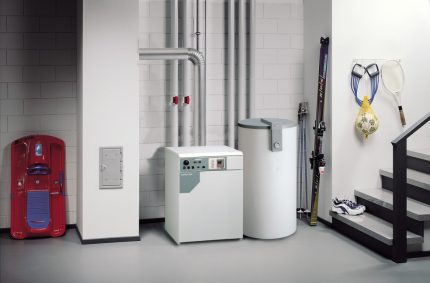
If condensation forms in the chimney, then the problem is in poor-quality thermal insulation of the chimney. Moreover, the formation of condensate droplets on the smoke channel can occur both due to insufficient insulation and from excess.
In pipes made of stainless steel, the problem of condensate formation can be solved by installing a condensate neutralizer and by completing with an element of removal of condensation moisture deposited on the pipe surface.
When assembling ordinary metal chimneys and sandwich chimneys, it is imperative that the assembly and connection of elements, which provides for spontaneous removal of condensate outside the chimney, be followed.
“Dew” warning in a turbine boiler
Models with a closed burner are equipped coaxial chimney. It provides a slope of 3 ° outward, i.e. from the boiler, it provides a spontaneous drain of condensate to the street.
The internal channel of the coaxial system is constantly cooled by the flow of air coming from the outside, due to which the temperature difference during normal operation is minimal.
The standard length of the coaxial smoke exhaust system is 1.2 meters. If elongation is necessary, (mandatory indoors), the distance should not exceed 6 meters.There should be at least 0.6 m between the outlet of the outer part of the coaxial chimney and the nearest obstacle (wall, large tree, etc.).
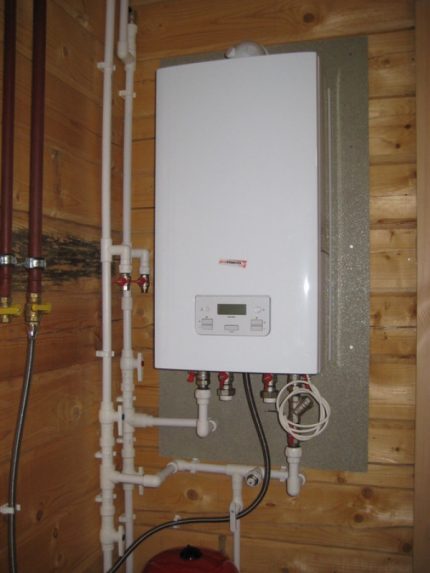
When using a boiler with a coaxial chimney in the northern regions, it is advisable to insulate the outer part of the outlet pipe. In this way, condensation can be prevented in the chimney of the gas boiler. After all, the difference between the temperatures of the incoming air flow and the exhaust flue gases will be reduced.
You can temporarily provide the boiler with air flow from the room. Most turbocharged floor and wall mounted gas boilers It is designed for the possibility of installing separate inflow and exhaust systems. You just need to find the plug of the hole to which the exhaust pipe should be connected, and slightly open it.
With an ajar plug for the exhaust duct, you can wait out frost. Then it must be covered tightly. Even in these cases, an increase in boiler power during the period of frost helps. In automated systems, a temporary reduction in the interval between the activation temperatures of the boiler and the shutdown of the boiler set by the hosts works well.
Feature of condensing boilers
The ideal solution is a condensing boiler, which is correctly balanced with the heating system, correctly configured and operates in the appropriate mode. In this case, the appearance of condensate is absolutely not harmful, because its energy is rationally used by the system itself.
The amount of gas saved directly depends on the amount of condensate formed. Condensation heat, which was formed during the operation of the equipment, is collected and redirected to the heating circuit. The efficiency of such a boiler is 98%.
Is condensation allowed to drain into the sewer?
During operation of the gas boiler, oxides are formed which react with water vapor. As a result, carbonic and sulfuric acids are formed, the average pH of which is 4. For comparison, the pH of beer is 4.5.
The acid solution is so weak that there are no restrictions on the discharge into public sewers. This rule applies if condensation has occurred on the pipe of a gas boiler operating in an apartment.
The only condition is that the condensate must be diluted with waste water 1 to 25. If the boiler power is more than 200 kW, it is necessary to install a condensate neutralizer. This requirement is indicated by the manufacturer in the equipment passport.
It is not possible to collect condensate into an autonomous sewer that discharges effluents to a septic tank with anaerobic bacteria or to a deep cleaning station using anaerobes and aerobes. It will destroy the biological environment involved in the cleaning process.
Chimney requirements for gas boilers
Today, in the construction of chimneys for gas boilers, various materials are used, most of which are impractical. Workmanship also leaves much to be desired.
Chimney made of asbestos cement. In the past, such chimneys had no alternative. Their main advantage is low cost.
Disadvantages:
- installation is carried out exclusively on vertical pipe sections;
- large weight and length, which complicates the installation;
- joints are not tight;
- moisture is absorbed into the walls;
- flue gas temperature not higher than 300 ºС.
It is important to connect the boiler to the chimney correctly. A tee is used for this purpose.
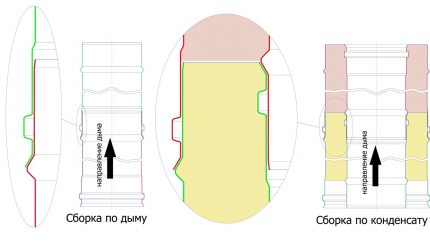
Be sure to have a steam trap and hatch for cleaning.
Brick chimneys. This material is not recommended for equipping systems with gas boilers.According to the requirements indicated in the SNiP 41-01-2003 collection, the flue ducts for gas processing equipment must be smooth and related to the class D gas density.
If the brick smoke channel is quite suitable for the gas density characteristics, then there can be no talk of the smoothness of the walls inside the pipe. Even if the seams of the brick pipe are perfectly ground with a mortar flush with the brickwork, during operation the relief will still appear due to the difference in the density of the material and the binder.
An ideal solution would be to install a metal sleeve inside a brick channel or assemble it from ceramic modules. A brick pipe with a metal or ceramic insert inside can last without problems for more than 30 years.
Furanflex lining is suitable for the same purpose. This polymer sleeve is made of composite (plastic reinforced with high-strength fibers). It is resistant to acid condensate, has a low thermal conductivity. Permissible temperature of use is up to 200 ºС.
Ceramic smoke ducts. This material is durable and durable. Ceramic chimney resistant to aggressive acids, easy to maintain and fireproof.
Ceramics can quickly heat up and cool for a long time. Installation of such a chimney requires the participation of specialists. The downside is the high cost.
Galvanized and steel. Under the influence of moisture, the steel rusts. The maximum shelf life of such pipes is up to three years. Galvanized chimneys, protected by a layer of zinc from rust, serve five or more years.
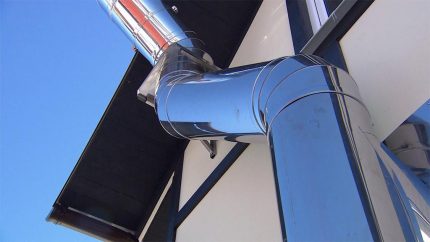
Stainless steel pipes. The perfect choice for arranging the smoke channel of a gas boiler. Its installation will cost several dozen times cheaper than the construction of a brick chimney. The walls are smooth, soot and tar will not settle on them, the gas density is quite high.
To assemble the chimney, you can purchase a set of single-layer modules or buy elements of a sandwich system. You can assemble such a design without much effort with your own hands. The main thing is to follow the direction when forming the connecting nodes.
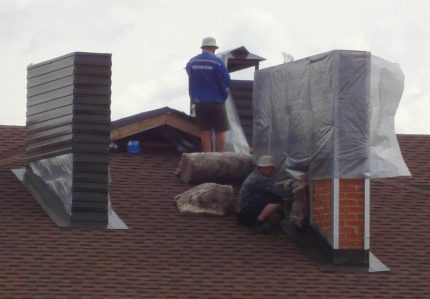
Advantages of stainless steel chimneys:
- due to the round section and smooth surface provide good traction;
- sealed;
- they quickly overcome the condensation threshold;
- easy to maintain;
- fireproof;
- durable.
Equally important is the quality of steel, weld, joints between the elements.
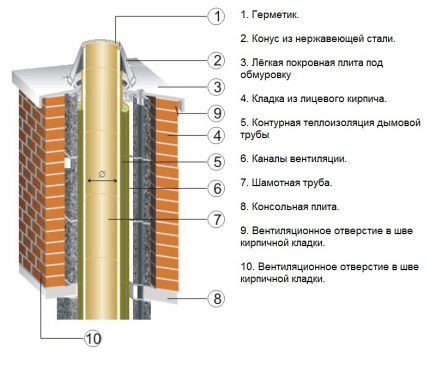
Often, the fact that repairing a chimney is much more expensive than competent installation at the stage of installing gas equipment is often not taken into account.
Chimney installation rules
The whole system must be insulated, waterproof and protected from aggressive materials.
The basic principles used during installation:
- collect the chimney should be "condensate";
- each joint is treated with a sealing compound;
- it is better to retreat from the vertical by a maximum of 30%;
- the length of inclined sections constructed at an angle of not more than 30º to the horizon - up to one meter;
- along the entire length of the channel, components of the same section are used.
It is recommended to install ready-made sets of chimneys, which are presented in specialized stores.
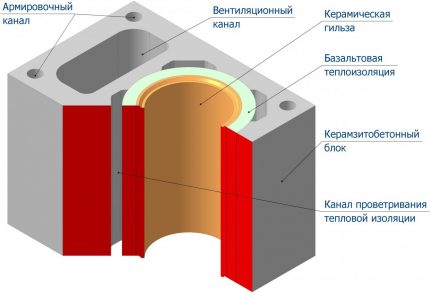
Recommended chimney system parameters for gas boilers:
- for the manufacture of the chimney, it is necessary to use corrosion-resistant steel type AISI 321;
- minimum thermal insulation - 50 mm;
- The system must include: a tee with a condensate collector, as well as a protective cone above the upper section of the chimney.
When choosing a chimney, you should pay attention to these characteristics.
Condensation Prevention
Forgetting moisture in the chimney forever will not work. The formation of condensate is inevitable, although during the continuous operation of the gas equipment, the “droplets” that have settled on startup will evaporate themselves and will no longer fall out while the unit is operating at full capacity.
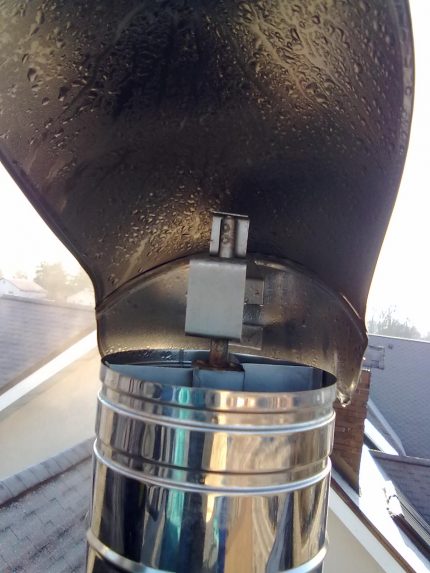
How to reduce the amount of condensate:
- to insulate the chimney channel;
- clean the system in a timely manner;
- use a steam trap.
If condensation builds up in a gas heating boiler, a container must be installed to collect excess fluid. The steam trap is a stainless steel tank in which moisture that has collected is collected.
The device is mounted under the outlet channel or pipe of the gas equipment. They also install a permanent drain into the sewer.
The problem of moisture formation in the chimney is better to prevent than to spend time and money then on its solution.
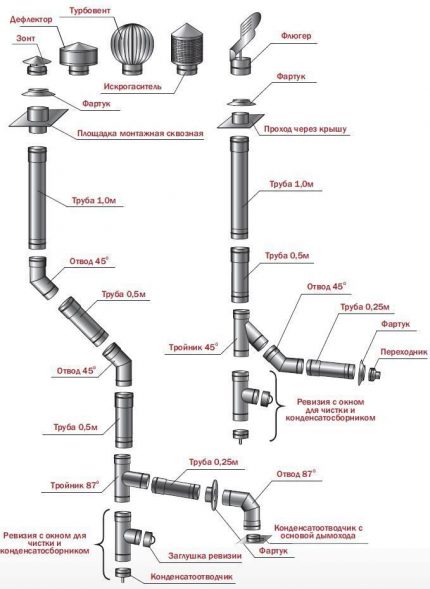
Prevention of moisture:
- adhere to all standards during the construction phase of the building;
- when installing the chimney, clearly follow the project;
- regularly maintain the smoke duct using specialized chimney cleaner;
- modernization of existing pipes (insulation, insert inserts from stainless steel);
- monitor the draft power and clean the chimney in time.
Chimney insulation is carried out using mineral wool or fibrous insulation. To insulate a brick chimney, plaster is used, which is laid in seven layers.
Determination of the probability of condensation
Calculations can be carried out if condensate is formed as a result of a large emission of steam and overheating of the chimney walls, and the power of the working equipment is also known. The average heat release rate is 1 kW per 10 square meters. m
The formula is relevant for rooms with ceilings below 3 m:
MK = S * UMK / 10
MK - boiler power (kW);
S is the area of the building where the equipment is installed;
CMD is an indicator depending on the climatic zone.
Indicator for various climatic zones:
- south - 0.9;
- north - 2;
- middle latitudes - 1.2.
When operating a double-circuit boiler, the resulting MK should be multiplied by an additional factor (0.25).
Conclusions and useful video on the topic
The following video will familiarize you with information on how to protect the boiler from condensation:
Features and benefits of installing a steam trap are presented in the video:
Condensation in the chimney is inevitable. Since this cannot be avoided, we told you about how to reduce the quality of moisture and protect equipment from aggressive fluids.
It is recommended to strengthen the chimney with stainless plates, install a condensate collector and monitor the presence of draft. Do not forget about cleaning the chimney, as well as preventing the condition of its walls.
If you have a successful experience of “dealing” with condensate, share your secrets in the comments. Readers who have questions can ask their experts online.


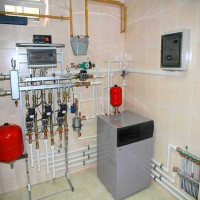 What to do if the gas boiler blows in the wind: causes of the boiler attenuation and methods for resolving the problem
What to do if the gas boiler blows in the wind: causes of the boiler attenuation and methods for resolving the problem 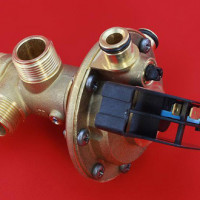 How to check a three-way valve in a gas boiler: DIY valve check instructions
How to check a three-way valve in a gas boiler: DIY valve check instructions 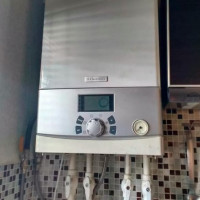 Error E4 in a gas boiler: decryption of code E04 + steps to solve the problem
Error E4 in a gas boiler: decryption of code E04 + steps to solve the problem 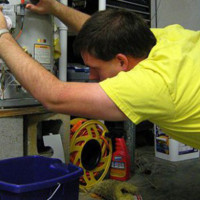 Water flows from a gas boiler: what to do if heating system equipment has flowed
Water flows from a gas boiler: what to do if heating system equipment has flowed 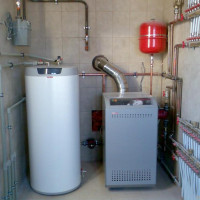 Why pressure drops in a gas boiler: causes of instability of pressure + ways to prevent problems
Why pressure drops in a gas boiler: causes of instability of pressure + ways to prevent problems 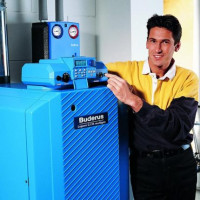 Maintenance and repair of gas boilers "Buderus": methods for dealing with typical breakdowns
Maintenance and repair of gas boilers "Buderus": methods for dealing with typical breakdowns  How much does it cost to connect gas to a private house: the price of organizing gas supply
How much does it cost to connect gas to a private house: the price of organizing gas supply  The best washing machines with dryer: model rating and customer tips
The best washing machines with dryer: model rating and customer tips  What is the color temperature of light and the nuances of choosing the temperature of the lamps to suit your needs
What is the color temperature of light and the nuances of choosing the temperature of the lamps to suit your needs  Replacement of a geyser in an apartment: replacement paperwork + basic norms and requirements
Replacement of a geyser in an apartment: replacement paperwork + basic norms and requirements